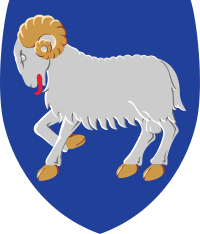Færeyinga saga
The Færeyinga Saga (![]()
Summary
It was written in Iceland shortly after 1200. The author is unknown and the original manuscript is lost to history, but passages of the original manuscript have been copied in other sagas, especially in three manuscripts: Óláfs saga Tryggvasonar en mesta, Flateyjarbók, and a manuscript registered as AM 62 fol.
The different sagas differ somewhat on the first settlement of the Faroes. Historians have understood from the beginning of Færeyinga Saga in Flateyjarbók that Grímur Kamban settled in the Faroes when Harald Fairhair was king of Norway (c.872-930 AD). This does not correspond with the writings of the Irish monk Dicuil.
However, the version from Ólafs saga Tryggvasonar does correspond with the writings of Dicuil. The opening text is, "There was a man named Grímr Kamban; he first settled in Faroe. But in the days of Harald Fairhair many men fled before the king’s overbearing." The first man to settle in Faroe is, according to this text, a man with a Norse first name and a Gaelic last name. This suggests that he might have come from Norse–Gael settlements to the south in Scotland or Ireland and probably wasn't Norwegian.
The text says that many men fled from Norway when Harald Fairhair was king there, but it also says that the isles were settled before that (possibly for hundreds of years, although most historians do not think so).
The Norwegians who fled from Harald Fairhair must have known about the isles before leaving Norway. If Grímr Kamban settled some time before, this could explain the Norwegians knowing about the Faroes.
According to Dicuil, a Hiberno-Scottish mission, the "Papar", lived in the Faroes (and Iceland) before Vikings came from Norway.
Sources
- Færeyínga saga eller Færøboernes historie i den islandske grundtekst med færøisk og dansk oversættelse Carl Christian Rafn, ed., Danish tr. Johan Hen(d)rik Schrøter, Faroese tr. (Copenhagen: J.H. Schultz 1832)
References
- "The History of the Making of the Saga (Faroese Ballads)". Archived from the original on 2015-05-15. Retrieved 2011-03-06.
Related reading
- Debes, Hans Jacob. Føroya søga 1. Norðurlond og Føroyar. (pp. 89–100. Føroya skúlabókagrunnur) 1990.
- Havsteen-Mikkelsen, Sven Føroyinga søga (Bjarni Niclasen, týddi; Jørgen Haugan, skrivaði eftirmæli. (Tórshavn: Føroya skúlabókagrunnur) 1995
External links
- Full text in Icelandic and English translation at the Icelandic Saga Database
- heimskringla.no - Færeyinga saga (in Icelandic)
